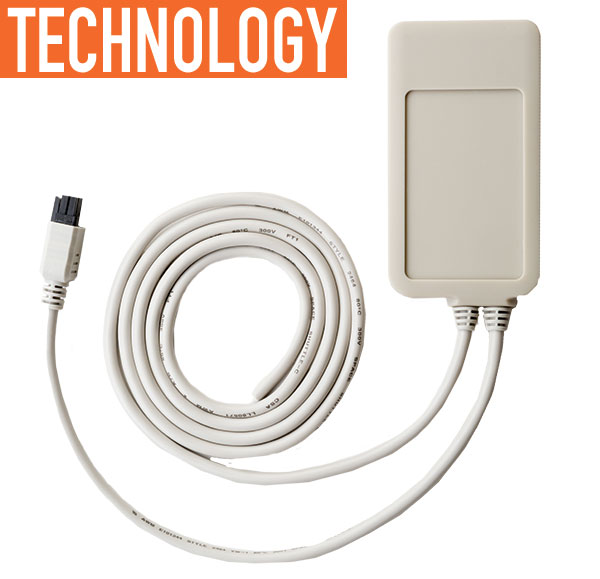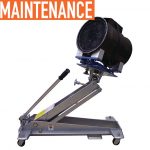Why are we doing fewer jobs and why is each job taking longer?
Years ago, I owned multiple carpet and upholstery cleaning franchises and oversaw 50 employees and a fleet of 15 trucks. In some ways, my business hinged on whether or not I could answer the two questions above. This uncertainty led me to a telematics tracking solution.
Compared to contemporary models, mine was expensive ($1,000 per truck) and primitive, but even then, it was a remarkably powerful tool. Those years of experience, during which I realized the benefits of a tracking solution from the fleet owner’s standpoint and saw those systems evolve and improve, formed my belief that a reliable, state-of-the-art tracking solution backed by an established provider is essential in today’s market.

The SA3000 is a commercial-grade GPS.
A telematics solution can also help grow your business, provided you know what to look for in a system. If, as a fleet owner, you haven’t yet taken advantage of this technology—or if you’re unsatisfied with your current system—then here are five keys to finding the system that will help your business reach its full potential.
- Be sure the provider is a viable company who wants to partner with you rather than just sell you something.
Since a tracking solution is going to be such a fundamental and ever-present part of your business, you’ll want a provider who’s established—i.e., in business for at least 10 years—and thus knows what it takes to build long-term client relationships. You want a provider who’s going to be there to answer questions, remedy any problems—quickly, on both counts—and provide expert guidance on how to get the most out of your system. You might also benefit from contracting with a provider who offers, either directly or through its parent company, a wider complement of services. Could you also benefit from, say, commercial fleet tracking on a larger scale, tank monitoring, or petroleum logistics? Find a provider who has the means to offer additional services under one brand umbrella via the same service team; even if you don’t think you need those services right away, your business needs may grow or change.A simple way to vet providers for these qualities is to talk to their current customers. Are they satisfied? What, if any, complaints do they have? Have those complaints been addressed or are they ongoing concerns? How a provider’s current customer answers these questions will be revealing. Ultimately, you’re looking for a provider who will work with you for the full life of the tracking system and who provides you with a customer success team as opposed to a lone rep whose job ends when the sale ends. - The system should feature simple and intuitive software.
Your fleet tracking solution is ultimately going to be only as useful as its interface. After all, system features will be of no use to you if you have trouble initiating them or accessing the information they provide. The system should be powerful, yet simple—easily comprehensible to those with even a passing familiarity with common business applications. Speaking of powerful, yet simple, some interfaces provide you with a comprehensive overview of your fleet on a single screen, even on your mobile device. Operating a good tracking solution should save you time, money, and resources—not become something else added to your list of tasks. - The system should have a monthly pricing option.
Some fleet managers will prefer to own their own monitoring solutions and assume full responsibility for their operation and upkeep. Others, though, may believe that SaaS-model systems, which are owned and maintained by the provider and centrally hosted, are a much more cost-effective solution.With SaaS-models, up-front capital costs are eliminated entirely and, since the provider still owns the hardware, no maintenance costs are involved. Instead, you, the client, pay a nominal monthly fee (less than $20 per month per unit, in the case of SkyBitz Local Fleets Economy package) for use of the equipment and for the multitude of real-time data and reports the trackers provide. Choosing such a pricing option means a return on investment from day one. However, not every provider offers this option. - The system must be capable of broadly monitoring and improving driver behavior.
My drivers were wasting time and, on occasion, operating company vehicles in an unsafe manner. However, once my employees in the field knew they must account for their time and their driving practices, their behavior changed almost immediately.As a result, each truck in our fleet roughly added an extra one or two stops per day, which increased our revenues by as much as $2,500 per day. Those kinds of gains add up in a hurry. At the same time, our payroll expenses went down because we were completing our jobs in less time. As well, our fuel costs went down 25 percent because drivers were spending less time making side trips that had nothing to do with our business or merely idling to excess in company vehicles.
To realize all these gains, you need a system that provides much more than dots on a map. You want data outputs that provide the full view of fleet and driver behavior—when they start and stop, when they’re idling, how much fuel they’re consuming, and whether routing and dispatch has been fully optimized. With leading systems, you can even monitor vehicle speed, acceleration, sudden braking, and hard cornering. In 2016, a system should offer reporting capabilities far beyond “mere” location tracking. - The product portfolio should be a flexible one.
You know your drivers best and thus you know the optimal way to help them perform better. In some instances, a plug-and-play solution that you install yourself and with the driver’s full knowledge will achieve the end goal of greater efficiency. The presence of the monitor serves as a “gentle reminder” of sorts for the driver and this new level of oversight functions as a corrective. In other cases, the fleet operator may want a professionally installed system that’s placed covertly on the vehicle and not accessible to the driver, so as to get a better idea of that driver’s “organic” behavior in company vehicles. Ideally, you’ll find an established company that offers both.
ABOUT THE AUTHOR:
Todd Lewis is VP of Sales for SkyBitz Local Fleets. Find out more about SkyBitz products and service, visit www.skybitz.com.
_______________________________________________________________________
MODERN WORKTRUCK SOLUTIONS: JULY 2016 ISSUE
Did you enjoy this article?
Subscribe to the FREE Digital Edition of Modern WorkTruck Solutions magazine.
![]()




